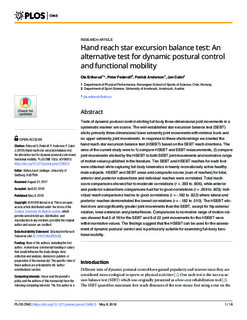| dc.contributor.author | Eriksrud, Ola | |
| dc.contributor.author | Federolf, Peter Andreas | |
| dc.contributor.author | Anderson, Patrick Julian | |
| dc.contributor.author | Cabri, Jan | |
| dc.date.accessioned | 2018-11-01T08:09:37Z | |
| dc.date.available | 2018-11-01T08:09:37Z | |
| dc.date.created | 2018-10-10T11:00:32Z | |
| dc.date.issued | 2018 | |
| dc.identifier.citation | PLoS ONE. 2018, 13, e0196813. | nb_NO |
| dc.identifier.issn | 1932-6203 | |
| dc.identifier.uri | http://hdl.handle.net/11250/2570499 | |
| dc.description | This is an open access article distributed under the terms of the Creative Commons Attribution License, which permits unrestricted use, distribution, and reproduction in any medium, provided the original author and source are credited. | nb_NO |
| dc.description.abstract | Tests of dynamic postural control eliciting full-body three-dimensional joint movements in a systematic manner are scarce. The well-established star excursion balance test (SEBT) elicits primarily three-dimensional lower extremity joint movements with minimal trunk and no upper extremity joint movements. In response to these shortcomings we created the hand reach star excursion balance test (HSEBT) based on the SEBT reach directions. The aims of the current study were to 1) compare HSEBT and SEBT measurements, 2) compare joint movements elicited by the HSEBT to both SEBT joint movements and normative range of motion values published in the literature. Ten SEBT and HSEBT reaches for each foot were obtained while capturing full-body kinematics in twenty recreationally active healthy male subjects. HSEBT and SEBT areas and composite scores (sum of reaches) for total, anterior and posterior subsections and individual reaches were correlated. Total reach score comparisons showed fair to moderate correlations (r = .393 to .606), while anterior and posterior subsections comparisons had fair to good correlations (r = .269 to .823). Individual reach comparisons had no to good correlations (r = -.182 to .822) where lateral and posterior reaches demonstrated the lowest correlations (r = -.182 to .510). The HSEBT elicited more and significantly greater joint movements than the SEBT, except for hip external rotation, knee extension and plantarflexion. Comparisons to normative range of motion values showed that 3 of 18 for the SEBT and 8 of 22 joint movements for the HSEBT were within normative values. The findings suggest that the HSEBT can be used for the assessment of dynamic postural control and is particularly suitable for examining full-body functional mobility. | nb_NO |
| dc.language.iso | eng | nb_NO |
| dc.subject | musculoskeletal system | nb_NO |
| dc.subject | knee joints | nb_NO |
| dc.subject | hip | nb_NO |
| dc.subject | ankles | nb_NO |
| dc.subject | postural control | nb_NO |
| dc.subject | shoulders | nb_NO |
| dc.subject | ankle joints | nb_NO |
| dc.title | Hand reach star excursion balance test: An alternative test for dynamic postural control and functional mobility | nb_NO |
| dc.title.alternative | Hand reach star excursion balance test: An alternative test for dynamic postural control and functional mobility | nb_NO |
| dc.type | Journal article | nb_NO |
| dc.type | Peer reviewed | nb_NO |
| dc.description.version | publishedVersion | nb_NO |
| dc.rights.holder | © 2018 Eriksrud et al. | nb_NO |
| dc.source.volume | 13 | nb_NO |
| dc.source.journal | PLoS ONE | nb_NO |
| dc.source.issue | 5 | nb_NO |
| dc.identifier.doi | 10.1371/journal.pone.0196813 | |
| dc.identifier.cristin | 1619278 | |
| dc.description.localcode | Seksjon for fysisk prestasjonsevne / Department of Physical Performance | nb_NO |
| cristin.unitcode | 150,31,0,0 | |
| cristin.unitname | Seksjon for fysisk prestasjonsevne | |
| cristin.ispublished | true | |
| cristin.fulltext | original | |
| cristin.qualitycode | 1 | |
